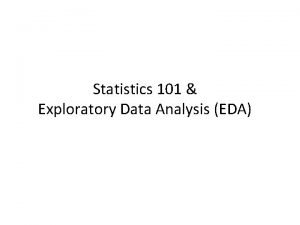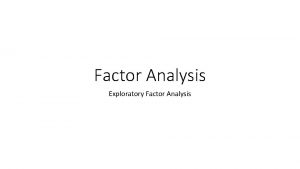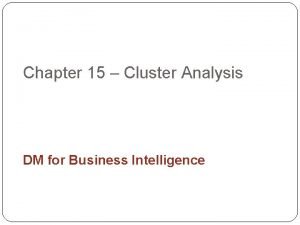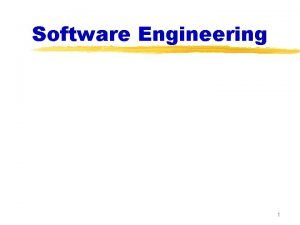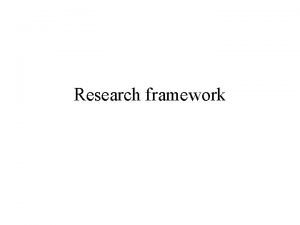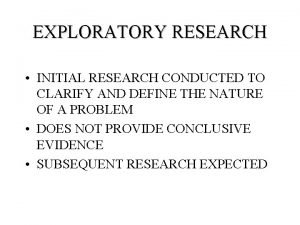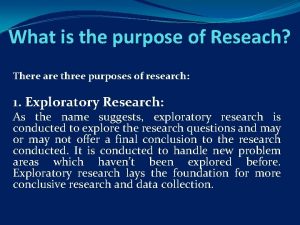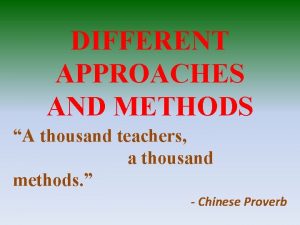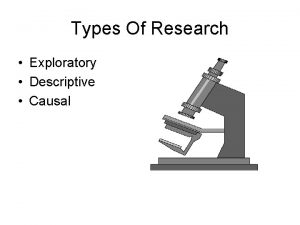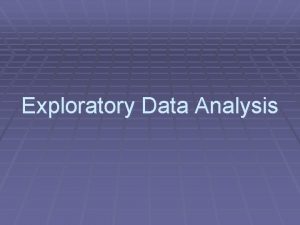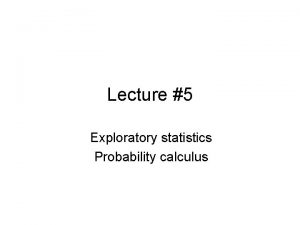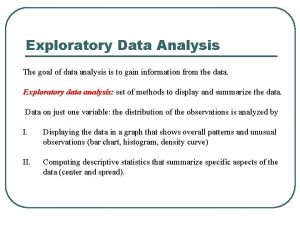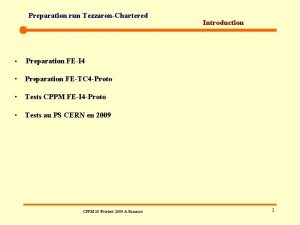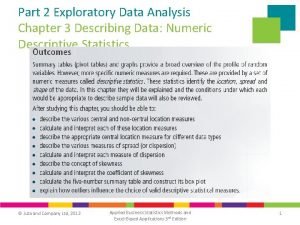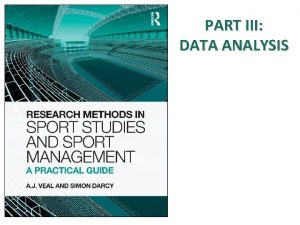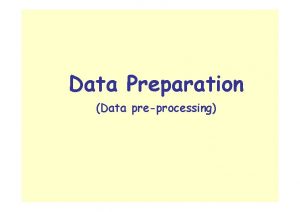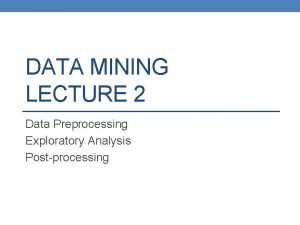Data Preparation Part 1 Exploratory Data Analysis Data
















































- Slides: 48

Data Preparation Part 1: Exploratory Data Analysis & Data Cleaning, Missing Data CAS Predictive Modeling Seminar Louise Francis Analytics and Actuarial Data Mining, Inc. www. data-mines. com Louise. francis@data-mines. cm 1

Objectives n Introduce data preparation and where it fits in in modeling process n Discuss Data Quality n Focus on a key part of data preparation n Exploratory data analysis n n n Identify data glitches and errors Understanding the data Identify possible transformations What to do about missing data n Provide resources on data preparation n 2

CRISP-DM n Guidelines for data mining projects n Gives overview of life cycle of data mining project n Defines different phases and activities that take place in phase 3

Modelling Process 4

Data Preprocessing 5

Data Quality Problem 6

Data Quality: A Problem n Actuary reviewing a database 7

May’s Law 8

It’s Not Just Us n “In just about any organization, the state of information quality is at the same low level” n Olson, Data Quality 9

Some Consequences of poor data quality n Affects quality (precision) of result n Can’t do modeling project because of data problems n If errors not found – modeling blunder 10

Data Exploration in Predictive Modeling 11

Exploratory Data Analysis n Typically the first step in analyzing data n Makes heavy use of graphical techniques n Also makes use of simple descriptive statistics n Purpose Find outliers (and errors) n Explore structure of the data n 12

Definition of EDA Exploratory data analysis (EDA) is that part of statistical practice concerned with reviewing, communicating and using data where there is a low level of knowledge about its cause system. . Many EDA techniques have been adopted into data mining and are being taught to young students as a way to introduce them to statistical thinking. - www. wikipedia. org 13

Example Data n Private passenger auto n Some variables are: n n n n Age Gender Marital status Zip code Earned premium Number of claims Incurred losses Paid losses 14

Some Methods for Numeric Data n Visual n Histograms n Box and Whisker Plots n Stem and Leaf Plots n Statistical n Descriptive statistics n Data spheres 15

Histograms n Can do them in Microsoft Excel 16

Histograms Frequencies for Age Variable 17

Histograms of Age Variable Varying Window Size 18

Formula for Window Width 19

Example of Suspicious Value 20

Discrete-Numeric Data 21

Filtered Data Filter out Unwanted Records 22

Box Plot Basics: Five – Point Summary n Minimum n 1 st quartile n Median n 2 nd quartile n Maximum 23

Functions for five point summary n =min(data range) n =quartile(data range 1) n =median(data range) n =quartile(data range, 3) n =max(data range) 24

Box and Whisker Plot 25

Plot of Heavy Tailed Data Paid Losses 26

Heavy Tailed Data – Log Scale 27

Box and Whisker Example 28

Descriptive Statistics Analysis Tool. Pak 29

Descriptive Statistics n Claimant age has minimum and maximums that are impossible 30

Data Spheres: The Mahalanobis Distance Statistic 31

Screening Many Variables at Once n Plot of Longitude and Latitude of zip codes in data n Examination of outliers indicated drivers in Ca and PR even though policies only in one mid-Atlantic state 32

Records With Unusual Values Flagged 33

Categorical Data: Data Cubes 34

Categorical Data n Data Cubes n Usually frequency tables n Search for missing values coded as blanks 35

Categorical Data n Table highlights inconsistent coding of marital status 36

Missing Data 37

Screening for Missing Data 38

Blanks as Missing 39

Types of Missing Values n Missing completely at random n Missing at random n Informative missing 40

Methods for Missing Values n Drop record if any variable used in model is missing n Drop variable n Data Imputation n Other n n CART, MARS use surrogate variables Expectation Maximization 41

Imputation n A method to “fill in” missing value n Use other variables (which have values) to predict value on missing variable n Involves building a model for variable with missing value n Y = f(x 1, x 2, …xn) 42

Example: Age Variable n About 14% of records missing values n Imputation will be illustrated with simple regression model n Age = a+b 1 X 1+b 2 X 2…bn. Xn 43

Model for Age 44

Missing Values n A problem for many traditional statistical models n Elimination of records missing on anything from analysis n Many data mining procedures have techniques built in for handling missing values n If too many records missing on a given variable, probably need to discard variable 45

Metadata 46

Metadata n Data about data n A reference that can be used in future modeling projects n Detailed description of the variables in the file, their meaning and permissible values 47

Library for Getting Started n Dasu and Johnson, Exploratory Data Mining and Data Cleaning, Wiley, 2003 n Francis, L. A. , “Dancing with Dirty Data: Methods for Exploring and Claeaning Data”, CAS Winter Forum, March 2005, www. casact. org n Find a comprehensive book for doing analysis in Excel such as: John Walkebach, Excel 2003 Formulas or Jospeh Schmuller, Statistical Analysis With Excel for Dummies n If you use R, get a book like: Fox, John, An R and S-PLUS Companion to Applied Regression, Sage Publications, 2002 48
 Exploratory data analysis lecture notes
Exploratory data analysis lecture notes Definition of eda
Definition of eda Data preparation and basic data analysis
Data preparation and basic data analysis Exploratory factor analysis
Exploratory factor analysis Clustering in business intelligence
Clustering in business intelligence Criteria for evaluating secondary data
Criteria for evaluating secondary data Exploratory research secondary data
Exploratory research secondary data Data preparation for data mining
Data preparation for data mining Addition symbol
Addition symbol Unit ratio definition
Unit ratio definition Part part whole
Part part whole Define technical description
Define technical description The heart of the entire beverage operation.
The heart of the entire beverage operation. The part of a shadow surrounding the darkest part
The part of a shadow surrounding the darkest part Two way anova minitab 17
Two way anova minitab 17 Examples of placement sae
Examples of placement sae The major emphasis in exploratory research is on
The major emphasis in exploratory research is on Exploratory style vs modern software development
Exploratory style vs modern software development Research design is a blueprint outline and a plan
Research design is a blueprint outline and a plan Conclusive research design example
Conclusive research design example Objectives of review of literature
Objectives of review of literature What are exploratory robots
What are exploratory robots Purpose of exploratory research
Purpose of exploratory research Exploratory essay introduction
Exploratory essay introduction Descriptive and causal research
Descriptive and causal research Defining and refining the problem
Defining and refining the problem Define reseach
Define reseach Sae idea cards
Sae idea cards Principles and methods of teaching
Principles and methods of teaching Simple application of exploratory decomposition
Simple application of exploratory decomposition Brand audit worksheet
Brand audit worksheet One's viewpoint towards teaching
One's viewpoint towards teaching Exploratory research
Exploratory research Exploratory decomposition examples
Exploratory decomposition examples Speculative decomposition
Speculative decomposition Structured exploratory testing
Structured exploratory testing Indirect/guided/exploratory approach
Indirect/guided/exploratory approach Brand is the added value endowed to products and services
Brand is the added value endowed to products and services Exploratory ind
Exploratory ind Research design meaning
Research design meaning Exploratory research vs conclusive research
Exploratory research vs conclusive research Nec diagnosis
Nec diagnosis Exploratory sae
Exploratory sae Experience survey in exploratory research
Experience survey in exploratory research Qualitative research procedures
Qualitative research procedures Exploratory descriptive causal
Exploratory descriptive causal What tasks do exploratory robots perform
What tasks do exploratory robots perform 雙向道
雙向道 Descriptive and causal inference
Descriptive and causal inference

